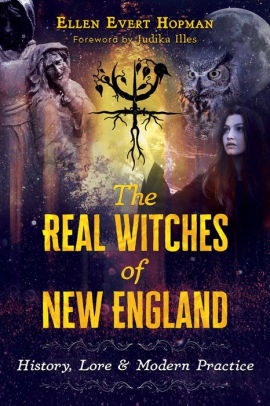Most books examining history fail their readers. Either they err on the side of accuracy and burden the reader with excruciatingly dry facts and footnotes or they fall prey to a juicy story that doesn't hold up to critical scrutiny. The Real Witches of New England: History, Lore & Modern Practice succeeds where others fail by weaving a rich, detailed, and fascinating narrative reaching back to 1400BCE and connecting it to current witches and their practices.
Composed of three sections: “History of Witch Persecutions,” “Accused Witches in New England and Interviews with Their Descendants,” and “Modern Witches of New England.” The first section is the most factual. Jumping right into the history of witch persecutions, Hopman discusses who was targeted (primarily ordinary people with little power or prominence), and why (they threatened those with power or controlled land/ had wealth that could be seized), including an insightful discourse on the underlying reasons for the persecutions. More than half of this section is a timeline of the persecutions, giving the reader a sense of how long witches have been seen as marginal. The section ends by looking at actual practices of witches, such as herbalism and divination, as described in a wide variety of source material. Packed with footnotes and references but never dull, the work offered here could easily become source material for student essays and term papers it is so well researched and documented. Hopman's delight in the subject matter -- whose sources include Orkadian Witch charms, lakeside healing rituals, excerpts from the Carmina Gadelica and Leechcraft, among others -- comes through clearly as she shares the knowledge with us.
The second section offers up interviews with some of the descendants of New England's accused witches, bringing the historical perspective right into the 21st century. Hopman notes that there are too many descendants to interview them all and admits that she hopes this section provides a glimpse into the kind of people came from those accused of witchcraft. Each descendant was asked how they discovered there was an accused witch in their family tree, their thoughts about most of the accused being women, how they define witchcraft, whether they felt a connection to their ancestor, and if they have had any experiences with modern Witches. Conducted vial email and utilizing the same questions for each, this is the weakest part of the book, in my opinion.
More than half of the book makes up the third and final section: email interviews with 25 modern day witches of New England. Of course, there are names the reader will likely recognize, such as Raven Grimassi, Christopher Penczak, Andrew Theitic, and Kirk White, but many were new to me. As in the second section, each was asked the same set of questions. The result is a unique recording of the various ways people define and practice witchcraft. I predict that this kind of documentation will prove invaluable to future historians. While all define themselves as a witch, the practices shared are far-reaching and distinctly not what one might call typical. Eclectic solitary Christopher Giroux's path has included encounters with Ifa of the Yoruba people, the teachings of a Mohawk elder, Buddhist meditation, the Trappist monk and mystic Thomas Merton, and the feminist liberation theology of Barbara Walker and Mary Daly. Christopher LaFond, an "astrological Priest" labels his path as “animistic Paganism,” which has “a noticeable lack of deities.” Sancista Brujo Luis practices "Puerto Rican Espiritism Criollo, traditional hispanic Brujeria," and says that "in Puerto Rico most Witches are channelers."
The scale and scope of Real Witches can feel unwieldy and incongruous as it jumps from medieval European woodcuts and books of Leechcraft to to the revelations of these modern-day Witches, but Hopman makes it work. To this reviewer the connections made across time and history provide a much-needed sense of continuity and grounding, anchoring our current re-imaginings in the past.
~review by Lisa Mc Sherry
Destiny Books, 2018
400 pages
ISBN 978-1620557723
The Real Witches of New England: History, Lore & Modern Practice

©
2010 - 2025
Facing North
